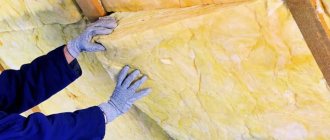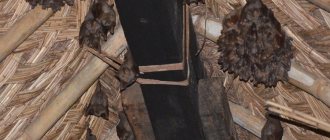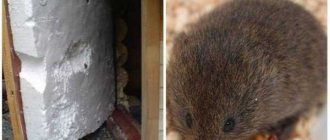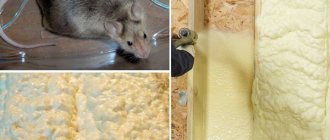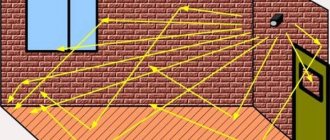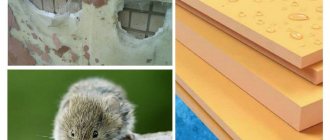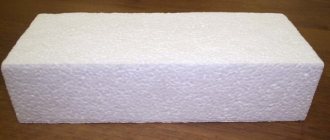Subscriber of the vk.com group L.A. Khomayko sent us his story of getting rid of mice in a house made of timber, as well as the most effective ways to combat rodents. Next is the author’s text.
Hello, friends! Last year I encountered one very unpleasant problem - there were mice in my house made of timber. In the fight against hated rodents, I studied a lot of different information and tried many different methods. And now, having considerable experience in breeding mice, I want to share it with site visitors.
The story of getting rid of mice in a log house
So, at the beginning of winter, mice, pursued by cold and hunger, begin to colonize human habitation. Yes, mice are always a serious problem in the house, and I had the opportunity to experience this personally. After all, rodents are not only a source of unpleasant odors and various types of infections; they also damage furniture, communications, and building materials. So today I will tell you:
- why do rodents get into the house?
- what materials do they like best?
- how to prevent mice from entering;
- How do we get rid of them?
I repeat, this article is the result of my small research into the problem and my personal experience . If someone disagrees with me, write about it in the comments, I will be happy to talk with you!
Mice in the house
Prices for poison for rodents
poison for rodents
Why is my house attractive to mice?
As I just said, rodents are driven into the house by cold and hunger. In the summer, they can feed from vegetable gardens, but when frost sets in, they always move to where food supplies are available.
Notice! Mice have an excellent sense of smell; they can sense food at a distance of up to 2 kilometers!
Why is a house attractive to mice?
A package of cereal in the kitchen, a bag of flour in the pantry... All this is a kind of magnet for rodents. And if you, like me, did not take care of protection from mice even at the stage of building a house, then nothing and no one will stop them. But the smell of food isn't everything; mice are also attracted to heat leaks.
The better the insulation of the house, the better the heat is insulated and the less it escapes outside, the less chance there is of attracting mice!
A neighbor advised me one interesting thing: when winter comes, thoroughly heat your log house, and then check it with a thermal imager. The detected places of heat loss are the routes for rodents to enter the home. Therefore, it is important to eliminate leaks as soon as possible!
Thermal imager for energy audit
As a rule, several large mouse families (colonies), consisting of a male, several females and their offspring, live within the same house. And if the house is heated and there is artificial lighting (and this almost always happens), then mice go beyond natural boundaries and begin to breed all year round (not only in the summer), and become active regardless of the time of day.
Several mouse families can live in one house
In a year, one female is capable of producing about 10 offspring, each of which consists of 3-12 individuals!
And all this brethren constantly needs to chew on something. This is not surprising, since mice’s incisors grow throughout their lives; if they do not grind them down regularly, they will simply die. The result is chewed wiring, plastic pipes, and often household appliances, floors, furniture and, of course, walls. And the walls of my house, as I already said, are made of timber. In a word, everything is quite serious, and therefore I decided to do something immediately.
Very often, mice hide in building materials and finished structures.
Prices for the Seek Thermal Reveal thermal imager
Seek Thermal Reveal Thermal Imager
Traps and repellers
- Mousetrap. You can, of course, set mousetraps. If the device is of high quality and sensitive, then the effect will be good. But there are several disadvantages here too. An ordinary person will hardly be able to distinguish a high-quality trap from a cheap fake. And then you will have to buy different models to identify the most effective one. If the trap is not lethal, the live mouse must be placed somewhere. And many people are very squeamish, which is true of mice, because they are carriers of diseases. In addition, traps will have to be constantly checked for the presence of bait and charged if the mousetrap runs out of charge, meaning the rodent managed to escape. Recently, sticky traps have become popular - these are small squares of thick cardboard coated with a very sticky substance, the mouse simply sticks to it. But it is disposable; after catching a rodent, the trap will have to be thrown away along with the captive.
- Ultrasonic repellers. Engineering thought continues to supply humanity with the necessary instruments. And so, an ultrasonic mouse repeller was invented. The device emits ultrasonic waves around itself, which are not detected by human hearing, but are loud and frightening to mice and rats. The device can be installed in any part of the house and is absolutely harmless to people. True, pets can also hear it, especially hamsters and guinea pigs. In general, mice are very afraid of loud sounds. There are known cases where, after installing an old music center in the basement and turning it on for 10 minutes several times a day, mice finally left the inhospitable house within a few days. There is no need to be afraid that you will have to keep the repeller on all the time. After the mice leave the house, it can be turned off for a long time. Mice rarely return to places where they were uncomfortable living. As for the power of the device, it is selected based on the area of the room that needs to be cleaned. It must be remembered that the manufacturer often indicates in the passport the maximum number of square meters, excluding walls and ceilings, therefore, when choosing a device, you need to make sure that it exceeds the required area by about 20%.
What is the danger of mice?
Material damage is not the only problem that can result from mice appearing in the house. These rodents are also carriers of a number of dangerous diseases and parasites.
Why are mice dangerous in the house?
I was able to find out that a house mouse can infect humans:
- toxoplasmosis;
- different types of fever;
- salmonellosis;
- bartonellosis;
- leptospirosis;
- tularemia;
- hantavirus infection and other dangerous diseases.
Moreover, ticks and fleas , which can quickly migrate to pets and even humans. Finally, mice are carriers of eggs of various helminths . All this made me take the problem seriously.
Which houses are at risk?
For rodents, it doesn’t matter what material the house is built from: they will happily live in a house made of timber (that is, in my house), or in a frame house, or in a stone house (with insulation). The favorite insulation of rodents is polystyrene foam: they gnaw passages in this material, build nests and then live peacefully with considerable pleasure. The glass mouse is also not neglected. But things are much better with ecowool: it is a loose, crumbly material in which rodents get entangled, and which, as far as I know, people try to avoid.
Mice love styrofoam
Main routes of penetration
Rodents enter a home in different ways, but the most common ones are the following:
- passages in the ground . By digging under the finishing of the foundation, mice penetrate under the floor, and from there, through gnawed holes and cracks, they enter the house;
- building materials In frame houses insulated with foam plastic, gas and foam concrete blocks, rodents settle much more often than we would like. So, mice can hide in some kind of building element, and then simply wait until the construction of the structure is completed;
- ventilation holes . Vents in the foundation that are not protected by bars are doors to the house that are hospitably open to rodents. Uninvited guests can settle in the ventilation ducts and fall through them into the ceiling, walls, etc.
There are different ways mice can get into your home.
Remember : for mice, what is much more important is not the material of the house, but its location! If the building is located near a field, then with the onset of autumn dozens of rodents will flock there.
But if you take care of protecting the house (preferably at the stage of its construction), block the openings with bars, and seal all the cracks, then the mice, realizing the futility of their attempts, may forget the way to your house forever.
Prices for electric mousetraps
electric mousetrap
Causes provocateurs leading to the appearance of rodents
Human habitation has always attracted rodents due to the presence of food. A frame house can serve as an ideal and easily accessible shelter for them, where entire colonies can spend the winter in warmth and abundance. They can penetrate here very easily, because it is difficult, when erecting a frame, to avoid the presence of cracks.
They can also penetrate the building through the finishing sheathing. If the insulation is incorrectly installed or chosen, voids often appear in it, through which rodents can move unhindered.
Advice! To prevent mice from choosing your home, choose those types of insulation that are not “interesting” to them.
A common reason that mice in a frame house have multiplied their colonies is the close localization of the structure to garbage beams or a landfill. Therefore, those who choose a place for building a frame structure must take this fact into account by locating their cottage as far as possible from them.
We solve the problem in advance: expanded clay castle
A method that was already too late for me to use, but it might be useful to you. The bottom line is that thanks to the expanded clay lock, mice will not be able to enter the home through the floor. In this case, expanded clay should be included in the floor cake. This is how it - the pie - should look (from bottom to top, i.e. from the ground):
- expanded clay (layer at least 30 cm thick);
- PET film;
- OSB-3 (2 layers);
- another layer of expanded clay;
- OSB sheets impregnated with synthetic wax and boric acid.
In such a cake, expanded clay will serve as a mechanical obstacle, and boric acid will act as a chemical repellent (until it wears off).
Expanded clay will help in the fight against mice
Another effective option is to cover the gaps with galvanized steel strips . The floorboards are laid along joists, without thermal insulation material, and the cracks are closed with strips (their width should be approximately 10 cm), which are nailed to the floor. Insulation material and sheathing are already laid on top of this.
Expert opinion: Afanasyev E.V.
Chief editor of the Stroyday.ru project. Engineer.
Want to learn more about rodent management and effective ways to control them? Read my detailed article - “what insulation mice won’t chew”
Prices for expanded clay in bags
expanded clay in bags
Exile
Pest Control
- Rats have an unusually developed sense of smell. But animals sense odors only at close range. If the rat is under the floor, through the cracks it will quietly hear the aroma of the plant that is left in the corners of the room.
- How to get rid of rats in an apartment on the first floor - the same as on all subsequent ones. Using folk remedies, professional ones.
- If a rat ran into the apartment and did not have time to finally settle in, you can drive it out with the smell of bleach or vinegar. The pest prefers rooms closer to food and water. Stops in the bathroom, toilet, dark hallway, toilet. In these rooms, you need to wash the floor in the evening with the addition of a bleach-based detergent, or add concentrated vinegar.
- Essential oils will help get rid of rodents. The aroma of lavender, mint, citrus fruits, lemon balm, and chamomile repel rats. Drop onto a candle and light it in the evening. The aroma penetrates into any cracks and remains in the room for a long time. If you don't have a candle, you can drop it on a night light bulb or add it to the water for washing floors.
- You can drive out a rat with ammonia. If you place a soaked rag near the hole, leave the poured product in the lid.
- Bunches of peppermint, chamomile, lemon balm, lavender, tansy, and wormwood plants are laid out in the corners of the room. It is necessary to ensure that the smell of the last two plants is not concentrated. Because the rich aroma of tansy and wormwood causes dizziness, nausea, and vomiting in a person.
- You can drive away large rodents yourself at home with the smell of burning wool. They set fire to old woolen socks, a scarf, and a ball of thread. They shove him into a hole and leave him on the floor along the walls.
If there are rats in your apartment, experts recommend using an ultrasonic rodent repeller. The device must operate continuously for a month. Ultrasound affects the nervous system of animals and forces them to leave the room. The effectiveness of the devices is questionable; whether to use a repeller or not is an individual decision.
We use metal mesh
According to biologists, a mouse is able to penetrate even into a hole that a pencil cannot fit into. And it is true. The skeleton of these rodents is very flexible, and the skull is capable of folding. Therefore, the galvanized mesh, which is used to protect the house from mice, must have the smallest cells. In addition, the mesh must be made of very durable material.
Important! I advise you to use a mesh made of wire more than 2 mm thick. In this case, the cell dimensions should not be more than 10x10 mm.
The mesh should be laid on the subfloor.
Laying fine mesh
The foundation is wrapped using a mesh.
Foundation protection with mesh
Or the ventilation holes are closed.
Closing the vents
All corners are covered with fine mesh (it will serve as reinforcement for the plaster), and it is important not to miss a single joint or corner.
You can't miss anything
In addition, such a mesh can be buried around the perimeter of the foundation (depth - at least 80 cm), so that rodents cannot dig under it. In short, it is better to lay fine mesh in all places where rodents can theoretically sneak through.
The base can be sheathed with a mesh to a height of at least 100 cm. And to further protect the base, it can be sheathed to the same height:
- smooth plastic (it should be slippery);
- profile sheet made of structural steel (recommended thickness - 1.5 mm, should be laid lengthwise in waves);
- plaster (acrylic putty is applied on top of the plaster to prevent mice from chewing through it, and only then slippery paint is applied).
The mesh will help protect your home from rodents
Proven methods of dealing with mice
Since I have personally experienced many methods, I can confidently say about the pros and cons of each of them, as well as which methods are effective and which are not. So, here are the conclusions I drew for myself.
- Various repellers , of course, are not bad, but they make such sounds that you yourself want to run away from the house along with the rodents.
- The use of poisoned baits guarantees that mouse corpses will lie in secluded corners.
- Mousetraps, even homemade ones, cope well with this task: for example, I caught mice using a plastic bottle. I poured a little oil into the bottle (I tried to use the kind in which seeds or fish were fried), generously lubricated the inside of the neck with it, and then strengthened the bottle at an angle of 45°. As a result, the rodents became victims of their powerful sense of smell: they climbed into the bottle, but could no longer get out.
The simplest bottle mousetrap - Will be an excellent assistant good cat. I acquired a real seasoned mouse catcher, which became one of the reasons why the mice left my house forever.
Get a good mouser - And my last tip is to apply a little liquid glue to a piece of cardboard. Place these cardboard boxes in areas where mice are likely to appear. A very effective method, but not everyone can calmly watch as a rodent stuck to cardboard slowly dies.
Popular ways to control rodents in the home
Lures
Representatives of the mouse family easily adapt to any living conditions, so they can eat almost all foods. Therefore, as bait you can use:
- cheese;
- peanut butter;
- bread;
- other aromatic products.
In addition, you can get a cat, which will save you from rodents in your dacha, because a pet will prevent their invasion. Even dogs scare away voles that might wander into the attic.
The use of poisons, of course, is effective, especially if the parasites are already running almost on your head, but it is worth remembering that some drugs are especially dangerous , so be careful, since children or pets can find poison baits.
Let's sum it up
You can get rid of mice; I managed to get them out of my house using timber. There are many ways, and many of them are very effective. But all methods are associated with unnecessary problems and discomfort, and therefore I advise you not to repeat my mistake and take into account the factor of the arrival of rodents at the construction stage.
I hope my short article was understandable and useful to you. If you have something to say (for example, share your method of removing mice), then be sure to write about it in the comments!
